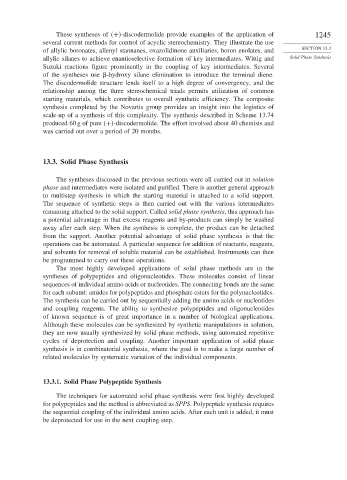Page 1269 - Advanced Organic Chemistry Part B - Reactions & Synthesis
P. 1269
These syntheses of + -discodermolide provide examples of the application of 1245
several current methods for control of acyclic stereochemistry. They illustrate the use
of allylic boronates, allenyl stannanes, oxazolidinone auxiliaries, boron enolates, and SECTION 13.3
allylic silanes to achieve enantioselective formation of key intermediates. Wittig and Solid Phase Synthesis
Suzuki reactions figure prominently in the coupling of key intermediates. Several
of the syntheses use -hydroxy silane elimination to introduce the terminal diene.
The discodermolide structure lends itself to a high degree of convergency, and the
relationship among the three stereochemical triads permits utilization of common
starting materials, which contributes to overall synthetic efficiency. The composite
synthesis completed by the Novartis group provides an insight into the logistics of
scale-up of a synthesis of this complexity. The synthesis described in Scheme 13.74
produced 60 g of pure + -discodermolide. The effort involved about 40 chemists and
was carried out over a period of 20 months.
13.3. Solid Phase Synthesis
The syntheses discussed in the previous sections were all carried out in solution
phase and intermediates were isolated and purified. There is another general approach
to multistep synthesis in which the starting material is attached to a solid support.
The sequence of synthetic steps is then carried out with the various intermediates
remaining attached to the solid support. Called solid phase synthesis, this approach has
a potential advantage in that excess reagents and by-products can simply be washed
away after each step. When the synthesis is complete, the product can be detached
from the support. Another potential advantage of solid phase synthesis is that the
operations can be automated. A particular sequence for addition of reactants, reagents,
and solvents for removal of soluble material can be established. Instruments can then
be programmed to carry out these operations.
The most highly developed applications of solid phase methods are in the
syntheses of polypeptides and oligonucleotides. These molecules consist of linear
sequences of individual amino acids or nucleotides. The connecting bonds are the same
for each subunit: amides for polypeptides and phosphate esters for the polynucleotides.
The synthesis can be carried out by sequentially adding the amino acids or nucleotides
and coupling reagents. The ability to synthesize polypeptides and oligonucleotides
of known sequence is of great importance in a number of biological applications.
Although these molecules can be synthesized by synthetic manipulations in solution,
they are now usually synthesized by solid phase methods, using automated repetitive
cycles of deprotection and coupling. Another important application of solid phase
synthesis is in combinatorial synthesis, where the goal is to make a large number of
related molecules by systematic variation of the individual components.
13.3.1. Solid Phase Polypeptide Synthesis
The techniques for automated solid phase synthesis were first highly developed
for polypeptides and the method is abbreviated as SPPS. Polypeptide synthesis requires
the sequential coupling of the individual amino acids. After each unit is added, it must
be deprotected for use in the next coupling step.

